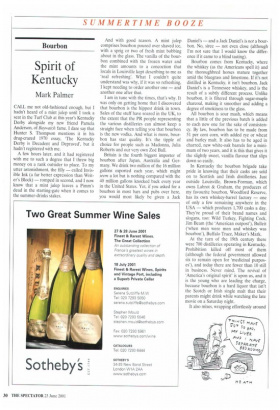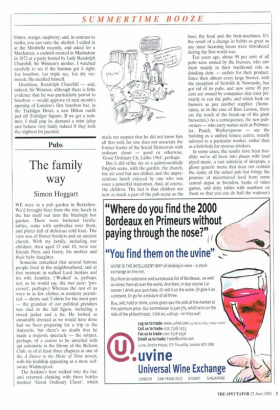Spirit of Kentuc
Mark Palmer
CALL me not old-fashioned enough, but I hadn't heard of a mint julep until I took a seat in the Turf Club at this year's Kentucky Derby alongside my new friend Pamela Anderson, of Baywatch fame. I dare say that Hunter S. Thompson mentions it in his drug-crazed 1970 essay, 'The Kentucky Derby is Decadent and Depraved', but it hadn't registered with me.
A few hours later, and it had registered with me to such a degree that I threw big money on a rank outsider to place. To my utter astonishment, the filly — called Invisible Ink (a far better expression than Writer's Block) — romped in second, and I now know that a mint julep leaves a Pimm's dead in the starting-gate when it comes to the summer-drinks stakes. And with good reason. A mint julep comprises bourbon poured over shaved ice, with a sprig or two of fresh mint bobbing about in the glass. The vanilla of the bourbon combined with the frozen water and the mint amounts to a concoction that locals in Louisville kept describing to me as 'real refreshing'. What I couldn't quite understand was why, if it was so refreshing, I kept needing to order another one — and another one after that.
I am in tune with the times, that's why. It was only on getting home that I discovered that bourbon is the hippest drink in town. Sales of the stuff have soared in the UK, to the extent that the PR people representing the various distilleries can almost keep a straight face when telling you that bourbon is the new vodka. And what is more, bourbon has star quality. It's the tipple of choice for people such as Madonna, Julia Roberts and our very own Zoe Ball.
Britain is the fourth biggest importer of bourbon after Japan, Australia and Germany. We drink two million of the 16 million gallons exported each year, which might seem a lot but is nothing compared with the 40 million gallons knocked back every year in the United States. Yet, if you asked for a bourbon in most bars and pubs over here, you would most likely be given a Jack Daniel's — and a Jack Daniel's is not a bourbon. No, siree — not even close (although I'm not sure that I would know the difference if it came to a blind tasting).
Bourbon comes from Kentucky, where the whiskey (as the Americans spell it) and the thoroughbred horses mature together amid the bluegrass and limestone. If it's not distilled in Kentucky, it isn't bourbon. Jack Daniel's is a Tennessee whiskey, and is the result of a subtly different process. Unlike bourbon, it is filtered through sugar-maple charcoal, making it smoother and adding a degree of smokiness to the glass.
All bourbon is sour mash, which means that a little of the previous batch is added to each new one for the sake of consistency. By law, bourbon has to be made from 51 per cent corn, with added rye or wheat and barley malt. It also has to be aged in charred, new white-oak barrels for a minimum of two years, and it is this that gives it the slightly sweet, vanilla flavour that slips down so easily.
In Kentucky the bourbon brigade take pride in knowing that their casks are sold on to Scottish and Irish distilleries. Just outside Louisville, Brown-Forman, which owns Labrot & Graham, the producers of my favourite bourbon, Woodford Reserve, has its own whiskey-barrel factory — one of only a few remaining anywhere in the USA — which produces 1,700 casks a day. They're proud of their brand names and slogans, too: Wild Turkey, Fighting Cock, Jim Beam (the 'American outpost'), Bulleit ('when men were men and whiskey was bourbon'), Buffalo Trace, Maker's Mark.
At the turn of the 19th century there were 700 distilleries operating in Kentucky. Prohibition killed off most of them (although the federal government allowed six to remain open for 'medicinal purposes'), and today there are fewer than 10 still in business. Never mind. The revival of 'America's original spirit' is upon us, and it is the young who are leading the charge, because bourbon is a hard liquor that isn't the Scotch or Irish single malt that their parents might drink while watching the late movie on a Saturday night.
It also mixes, wrapping effortlessly around bitters, mango, raspberry; and, in contrast to vodka, you can taste the alcohol. I called in at the Mirabelle recently, and asked for a Manhattan, a cocktail created in Manhattan in 1872 at a party hosted by Lady Randolph Churchill, Sir Winston's mother. I watched carefully to see if the barman got it right: loz bourbon, loz triple sec, loz dry vermouth. He excelled himself.
Doubtless, Randolph Churchill — and, indeed, Sir Winston, although there is little evidence that he was particularly partial to bourbon — would approve of next month's opening of London's first bourbon bar, in the Trafalgar Hotel, a new Hilton outfit just off Trafalgar Square. If we get a summer. I shall pop in, demand a mint julep and behave very badly indeed if they look the slightest bit puzzled.



































































 Previous page
Previous page